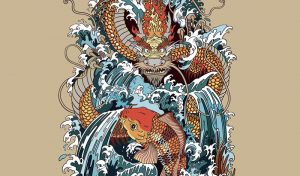Background
Nichiren Daishonin wrote this letter in January 1266. The letter’s content suggests the recipient was a woman who lived in Amatsu of Awa Province who had formerly believed in the Pure Land (Nembutsu) teachings and was relatively new to faith in Nichiren Buddhism.
In the letter, Nichiren explains in plain terms the rewards of the simple practice of chanting Nam-myoho-renge-kyo, saying that this phrase and its components contain all the powers of the Buddha. One who chants this phrase can tap all the benefits of Buddhism and thus revitalize one’s life.
In the first section of the letter, he addresses the question of whether one can benefit from chanting Nam-myoho-renge-kyo without understanding the meaning of the Lotus Sutra. He stresses the necessity of faith in attaining Buddhahood.
In the second section, the Daishonin clarifies the great blessings contained in the five characters of Myoho-renge-kyo, the title of the Lotus Sutra. He explains three meanings of the character myo: to open, to be fully endowed and to revive. Finally, he states that only the Lotus Sutra enables women to attain Buddhahood, urging the letter’s recipient to chant Nam-myoho-renge-kyo and forsake her attachment to the Nembutsu.
PASSAGE 1
“Nam-myoho-renge-kyo.
Question: Is it possible, without understanding the meaning of the Lotus Sutra, but merely by chanting the five or seven characters of Nam-myoho-renge-kyo once a day, once a month, or simply once a year, once a decade, or once in a lifetime, to avoid being drawn into trivial or serious acts of evil, to escape falling into the four evil paths, and instead to eventually reach the stage of non-regression?
Answer: Yes, it is.” (The Writings of Nichiren Daishonin, vol. 1, p. 141)
IKEDA SENSEI’S COMMENTARY
What kind of power do the seven characters of Nam-myoho-renge-kyo contain?
The Daishonin starts this letter by asking, “Is there really any benefit in chanting Nam-myoho-renge-kyo even just once without understanding its meaning?” and then goes on to clearly outline the enormous power of the daimoku of the Lotus Sutra—Nam-myoho-renge-kyo. …
From the very beginning, Nichiren Daishonin asserts that the benefit of chanting Nam-myoho-renge-kyo is immense beyond measure. He affirms that it is indeed possible “merely by chanting the five or seven characters of Nam-myoho-renge-kyo once a day, once a month, or simply once a year, once a decade, or once in a lifetime, to avoid being drawn into trivial or serious acts of evil, to escape falling into the four evil paths, and instead to eventually reach the stage of non-regression.”
Because the Mystic Law has the vast and limitless power of the Buddha and the power of the Law, it can transform any kind of negative karma. …
Nam-myoho-renge-kyo, the seed of Buddhahood, contains the causes of all the innumerable practices that lead to enlightenment and the effects of all the superlative good fortune and benefit to be gained upon attaining enlightenment. That’s why, if we just plant that seed in the field of our hearts a single time, we are guaranteed to be able to realize the same life state as the Buddha. (The Teachings for Victory, vol. 7, p. 21)
PASSAGE 2
“Coming now to the character myo [wonderful or mystic], the Lotus Sutra says, “This sutra opens the gate of expedient means and shows the form of true reality.” The Great Teacher Chang-an states, “Myo means to reveal the depths of the secret storehouse.” The Great Teacher Miao-lo says of this, “To reveal means to open.” Hence the character myo means to open.
If there is a storehouse full of treasures but no key, then it cannot be opened, and if it cannot be opened, then the treasures inside cannot be seen.” (WND-1, 145)
IKEDA SENSEI’S COMMENTARY
The Lotus Sutra is the sole scripture that opens the way for the enlightenment of all living beings, which is the ultimate purpose of Buddhism.
The Mystic Law has the power to open the treasure storehouse that resides within all human beings—that is, the world of Buddhahood latent within the reality of the nine worlds—and to invigorate their lives.
In the various sutras taught before the Lotus Sutra, the storehouse containing the treasure of the Mystic Law—the essence of the Buddha’s supreme enlightenment—remains closed. The storehouse may be visible, but no one has yet seen the treasure inside.
But with the teaching of the Lotus Sutra, which elucidates the principle of universal enlightenment, the storehouse of all the earlier scriptures is opened for the first time, revealing the treasure of the Mystic Law, the ultimate teaching that Shakyamuni wished to convey.
In this section, the Daishonin highlights the most essential aim of Buddhism. The various other sutras detail the Buddha’s lofty character and the vastness of his enlightenment, but unless all people can access those teachings, they are of no benefit.
The true value of Buddhism can be demonstrated only if we can transform our lives and manifest in the course of our everyday reality the same supremely noble life state as the Buddha. (The Teachings for Victory, vol. 7, pp. 25–26)
PASSAGE 3
“Myo means to be fully endowed, which in turn has the meaning of “perfect and full.” Each word and each character of the Lotus Sutra contains within it all the 69,384 characters that compose the sutra. To illustrate, one drop of the great ocean contains within it the waters of all the various rivers that flow into the ocean, and a single wish-granting jewel, though no bigger than a mustard seed, is capable of showering down the treasures that one could wish for with all the wish-granting jewels.” (WND-1, 146)
IKEDA SENSEI’S COMMENTARY
All the benefits of the Lotus Sutra without exception are included and inherent within the single character myo. Myoho (Wonderful Law, or Mystic Law) is the Chinese translation of the Sanskrit word saddharma offered by the Buddhist scholar and translator Kumarajiva (344–413). The sad of saddharma is said to have the meaning of perfect and complete.
In other words, just as all possible treasures can be produced by a wish-granting jewel as small as a mustard seed, and just as plants and trees withered and bare in autumn and winter can send forth green leaves, beautiful flowers, and fruit in response to the light and warmth of the spring and summer sun, every character of the Lotus Sutra contains all teachings and benefits, and can revitalize all things.
The sound of chanting Nam-myoho-renge-kyo has the power to activate the noble Buddha nature inherent in the life of the universe. That is why, the moment we chant Nam-myoho-renge-kyo, the Buddhas and heavenly deities begin to extend us their protection and everything and everyone become our ally. (The Teachings for Victory, vol. 7, p. 27)
PASSAGE 4
“Myo [wonderful or mystic] means to revive, that is, to return to life.” (WND-1, 149)
IKEDA SENSEI’S COMMENTARY
This expresses the immeasurable and boundless benefit of the Mystic Law that has the power to revive all living beings and enable them to attain Buddhahood. It indicates that those deemed unable to attain Buddhahood in the sutras before the Lotus Sutra—evil persons, women and persons of the two vehicles—can indeed do so (see WND-1, 149). …
Here, the Daishonin clearly states that the Lotus Sutra teaches the principle of universal enlightenment—a principle not taught in any other sutra. It reveals that evil persons, women, and others denied the possibility of enlightenment by the other sutras can in fact attain Buddhahood. This revelation opens the way to the attainment of Buddhahood by all living beings.
Another way of looking at this is that, though everyone else may have given up on someone, the Lotus Sutra does not. By embracing the Mystic Law, all people, without exception, can attain the life state of Buddhahood. This brilliant light of hope can fundamentally transform the destiny of humankind. The revitalizing power of the Mystic Law is the energy source for transforming our lives from the depths of suffering into lives filled with the joy of value creation. (The Teachings for Victory, vol. 7, pp. 27–28)
You are reading {{ meterCount }} of {{ meterMax }} free premium articles





